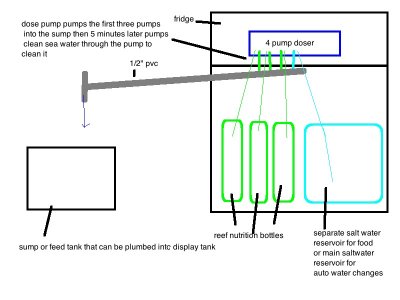goleafsgo
New member
Hi guys I've been reading up the the thread in the nps coral forms about a continuous doser for live food and was looking to modify it alittle. I dont like how the current method has a water constantly recirculating through the fridge. it just seem that if something goes wrong your tank could suffer. I would rather my autofeeder or floor suffer vs my tank.
Keep in mind that this is part of my Fully Automated nano build which will use auto water changes using an apex dos pump along with an apex control to monitor and regulate tank salinity. My goal is to eliminate weekly maintenance and keep monthly maintenance to a minimum.
My current auto feeder design will feed twice aday 3 different types of live food, then flush the tubes with clean salt water. water will then be extracted from the tank via water change. I will have to see over acouple weeks how salinity is effected to start to dial in on how much water to flush with vs take away.
the feeder will work by having a 4 channel dosing pump inside a fridge along with 3 reef nutrition products. I will drill 4 holes in a pvc pipe and set it so it is slanted and leads to my return pump. the end of the pvc pipe will be above the waters surface. Once the 3 nr products are fed to the tank, a largish amount of saltwater will be pumped from the 4th channel to flush out any remaining food in the pvc pipe. water will then be taken out of the tank via dos apex. I am also thinking about using the dos apex pump to run water changes through the pvc pipe so that i can know exactly how much water is going into the tank and i can take the same amount out.
see attachment for diagram
Keep in mind that this is part of my Fully Automated nano build which will use auto water changes using an apex dos pump along with an apex control to monitor and regulate tank salinity. My goal is to eliminate weekly maintenance and keep monthly maintenance to a minimum.
My current auto feeder design will feed twice aday 3 different types of live food, then flush the tubes with clean salt water. water will then be extracted from the tank via water change. I will have to see over acouple weeks how salinity is effected to start to dial in on how much water to flush with vs take away.
the feeder will work by having a 4 channel dosing pump inside a fridge along with 3 reef nutrition products. I will drill 4 holes in a pvc pipe and set it so it is slanted and leads to my return pump. the end of the pvc pipe will be above the waters surface. Once the 3 nr products are fed to the tank, a largish amount of saltwater will be pumped from the 4th channel to flush out any remaining food in the pvc pipe. water will then be taken out of the tank via dos apex. I am also thinking about using the dos apex pump to run water changes through the pvc pipe so that i can know exactly how much water is going into the tank and i can take the same amount out.
see attachment for diagram

